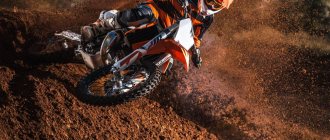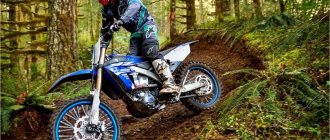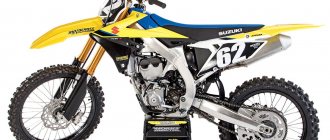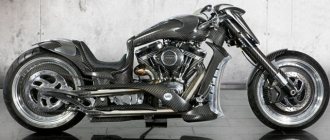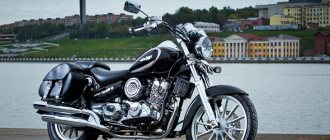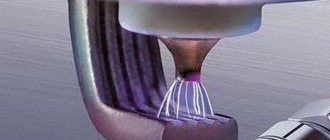The Kawasaki KX250F cross-country motorcycle was released in 2004 as a logical continuation of the KX250 and KX125 models. The first bikes were produced in collaboration with Suzuki, which did not have the best effect on the model.
Until 2006, the bike was so similar to the Suzuki RM-Z250 that some dealers, when offering them, explained that: “They are the same model, only the names are different.”
Appearance
The Kawasaki KX 250F looks typical. Straight handlebars of medium height, spoked wheels, high fenders... There is no detail that would distinguish this motocross motorcycle from many others. Another thing is the technical characteristics. They're really on top here.
All variants of this car have green in their design in one way or another. For a Kawasaki bike this is not surprising.
This is a win-win design option for a sports bike. The bright green color, by the way, suits a sport bike no less well, but it’s impossible to say the same about road motorcycles. This is clear from the video and photos.
Modifications
The developers are silent about individual modifications, but in the description of the model there are both variants with symbols 250, and 252, 255. And we are not talking about the engine size.
This is probably an internal factory designation for models of different generations.
and competitors
Suzuki RM-Z250.
Honda CRF250R.
Yamaha YZ250F.
Suzuki RM-Z250 clone, Honda and Yamaha also presented their models. The first one was a Honda CRF250R . In addition to the motocross model, it also competed in the enduro class, introducing the CRF250X (also known as the CRF250RX ).
The second did not spray and presented only the Yamaha YZ250F motocross motorcycle.
All four (including Kawasaki) were launched in different years, but are still being produced.
Comfort
The car is comfortable on the track and in rural areas. Otherwise, road motorcycles and even enduro motorcycles are much more convenient. What this technique is definitely not suitable for is tourism. Neither the seat nor the tank volume help to achieve comfort while traveling.
Besides, this won't last long. Even if you plan your route correctly, you will still run out of fuel very quickly.
The car has proven itself in motocross handling. It takes turns on hills faster than many other models driven by the same professional, traverses sand better and jumps further from jumps. In many ways, this has to do with well-chosen dimensions and technical characteristics.
Kawasaki aluminum outer frame concept
When Kawasaki first unveiled its aluminum outer frame concept, it was received with open arms, praising the handling and ergonomics. The frame is now undergoing its third major redesign, and the 2015 model's shape benefits from adjustable pedals. Perhaps for the average rider, the ability to lower the pedals will not be a fundamental factor when buying a new motorcycle. However, for taller bikers, that extra 5mm (0.2 inches) makes a world of difference, not only in terms of the ability to grip the bike with your legs, but also when transitioning from a sitting to a standing position. Add to that the lowered spare pedals and you've got up to 10mm (0.4 inches) extra, enough to feel the difference in position.
The shape of the frame allows you to grip the bike with your legs, allowing for even better control on the track. On the straights, the bumpy sections, and the zigzag strip (although there aren't many sharp turns at the Milestone MX track where this test ride took place), the Kawasaki showed stability at the maximum level for motocross bikes. The driver can be sure that the bike will not pull to the side when accelerating or sharp braking. Shaking and unreliability of the rear axle are not things that could be said about the KX250F.
Dimensions and weight
The dimensions of this machine correspond to the tasks assigned to it. Thanks to its length and ground clearance, the bike successfully overcomes uneven surfaces.
Thanks to the height, such ground clearance is possible. Finally, thanks to the tank volume, the bike is lightweight and therefore performs well on jump stunts.
The dimensions are as follows:
- height – 1270 mm;
- width – 825 mm;
- length – 2172 mm;
- wheelbase – 1478 mm;
- seat height – 945 mm;
- ground clearance - 324 mm;
- curb weight - 104.5 kg;
- Tank capacity – 6.4 l.
The bike's curb weight makes it capable of winning motocross. At the same time, it cannot be said that these are the most successful parameters that could ideally be. Often in one review or another it is mentioned that the tank volume could be a little smaller, and then the performance would improve.
But such statements are doubtful, because this would not only create inconvenience, but would make the motorcycle unsuitable for more or less long-term competitions.
Weight
As they write in some publications: unlike competitors who are trying to create a model weighing less than 100 kg, Kawasaki does not play these games.
The developers admit that their versions are more than 100 kg, but this was done deliberately. If you use all their technologies and at the same time reduce the weight, the motorcycle will simply fly into the air, so the mass of their models is a spoiler for a sports car.
However, the weight of their product is not much different from 100 kg. The curb weight of the bike, fully fueled and ready to ride, weighs only 104 kg . During the development process it reached 106 kg .
Specifications
In terms of features, the motorcycle is a typical representative of the motocross class. A powerful engine relative to the volume and dimensions of the bike, a reliable and lightweight chassis, and a fast transmission. In short, it has everything you need to be a fast and dynamic motocross winner.
| Motor type | in-line, 1 cylinder, 4 stroke |
| Power | 43 hp |
| Torque | 28.7 Nm |
| Maximum speed | 230 km/h |
| Acceleration to 100 | 3.5 s |
| Fuel consumption per hundred | 3 l |
| Drive unit | chain |
| Transmission | five-speed |
| Frame | half-duplex aluminum |
| Rear suspension | pendulum, monoshock absorber, stroke 310 mm |
| Front suspension | inverted fork, 310 mm travel |
| Rear brakes | 1 disc, 240 mm, 1-piston caliper |
| Front brakes | 1 disc, 270 mm, 2-piston caliper |
All this makes this bike stop on time, be strong and soft on jump landings, and be relatively loud. The latter, however, applies to most representatives of the cross-country class. This is why they are not yet suitable for crowded places. The sound of the engine is similar to the sound of a chainsaw.
Flaws
- Loud muffler — even forward flow cannot compare with the howl of the engine in a normal situation.
The muffler is raised right under the saddle and covered with a protective pad.
- Lack of power at low revs - do not forget that the motorcycle is not for regular riding, but for circuit racing, where people usually ride at other rev ranges.
and dignity
The main competitive advantage of the model is, of course, the power plant. It was Kawasaki that was the first to cross the 40 hp bar. With. and raised the requirements for motocross motorcycles to a new level.
At the same time it is noted:
- Comfortable fit . Although the pilot does not often sit during the race, the saddle is quite large - not typical for ordinary cross-country models.
- Handling is a necessary quality for a cross-country model.
- Stability on a given track . For cross-country, this is rather an exception to the rule, but a positive exception.
- Price . The brand does not always have a price-quality ratio in favor of the latter, but by assembling this model, the developers managed to create a balanced ratio of one to the other.
Naturally, power is also a plus, but here they write about excellent power and output at high and medium speeds.
What do the owners say?
Judging by the reviews, this bike is great for motocross. It is advised to take this model, since it is still in production and meets all the requirements of current competitions and environmental standards.
Spare parts for this equipment are easy to obtain, and therefore maintenance will not be expensive. For the cross-country version, this is important, because no matter how strong the equipment, the risk of breakdowns is high due to extreme operating conditions.
Of course, all owners advise buying a new bike. It is possible to get a good used one, but there is a risk that something somewhere will break faster. According to the owners' description, the motorcycle handles well in rural areas, but is less comfortable on the road than road variants and even enduros.
It is possible to buy new equipment for about 300 thousand Russian rubles, but according to reviews from those who bought a used one, in this case it is possible to purchase a bike several times cheaper. About 150 thousand Russian rubles - that’s how much such a bike costs on the secondary market. But this is the minimum.
In conclusion, it is worth noting that the Kawasaki KX 250F is a machine that has proven itself. The bike looks interesting and bright. It does not and cannot have any special differences from other motocross bikes. These machines have been made approximately the same for many decades.
Features of Kawasaki KX250F
Apart from the engine, which pulls well at medium and high speeds, which is a necessity for a motocross bike, and the Launch control that appeared in 2014, the bike does not have any special differences.
An interesting feature is the ability to change engine parameters without disassembling the bike. There is a special connector on the steering column.
The card slot is located on the right side of the steering column.
- Installing a black card into it gives the command to deliver maximum power at medium speeds, which is good for hard roads.
- The white card will transfer the recoil to the top, for riding on clay or on slippery roads.
- Green - will place it in the middle between the extreme positions.
Three colors – three engine operating modes.
It is curious that the cards have a non-random name. It depends on the external design and main color of the module.
Rear shock absorber from Showa
An updated Showa rear shock balances the bike and provides a smooth, even ride. Still, there was a slight sag under my weight, and the ride quality was average. But after Brett Leaf, our Kawasaki mechanic, made some adjustments to the compression settings and turned the tension bolt half a turn, I felt more comfortable on the bike. If I had a choice, on a flat section at a constant speed I would prefer a stiffer spring shock absorber.
Overall, Kawasaki is shaping up to be a strong project for 2015. Racing experience is always a nice bonus, but the fact remains that the bike behaves differently with different riders. In the case of the KX250F, I was pleased. But one day on one track cannot give a complete picture of the capabilities of a motorcycle. However, the desire to test the bike in other conditions outside shows that Kawasaki did something right. I'd love to ride the 2015 KX250F again... and again.
KX250F Front Suspension Enhancements
Kawasaki was the first company to release a split-function fork as an original equipment component, so they had years to perfect the front suspension. For 2015, updated Showa fork valves provide smooth, predictable ride. Potholes and bumps are effectively absorbed with the low kickback you'd expect from a well-balanced traditional spring fork. Jump and landing positions are also continuously adjustable, so nothing caught me off guard.
Related to the KX250F's aforementioned cornering characteristics, the suspension absorbs shock enough to keep you firmly planted on the bike. The petal discs provide excellent stopping power, and the fork travel allows you to maintain full traction.

